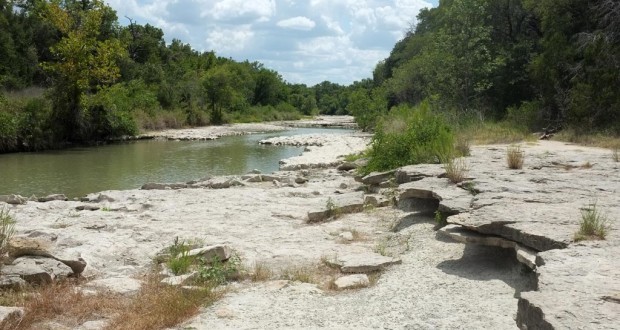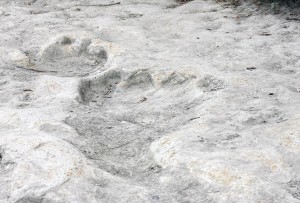Today, the remaining dinosaur tracks on the site are the centerpiece of Dinosaur Valley State Park. Originally pressed into the mud of a shallow, prehistoric sea, they are now preserved in a layer of white limestone along the river.
The larger, rounded footprints, which often appear in front-and-back pairs, come from a sauropod. Those are the enormous dinosaurs with a long neck on one end, balanced by a long tail on the other. The displays at the site say the tracks came from the brachiosaur Pleurocoelus, but later research on nearby bones apparently concluded it was a new species dubbed Paluxysaurus jonesi. Paluxysaurus stood about 12 feet high and more than 60 feet long, weighing in at 20 tons.
Much easier to spot in the river bed are the sharp, three-toed tracks of the Acrocanthosaurus, a theropod about 25 feet in length that ran on two legs. It was a smaller cousin of the more familiar Tyrannosaurus rex but had similar carnivorous habits.
The footprints represented the first sauropod trackway ever found and, among other things, confirmed that they walked with their tails off the ground. Large sections of the trackway depicting the alleged dinosaur fight were removed in 1940 by Roland T. Bird, as he explains in this Natural History magazine article from 1941. One section went to the Texas Memorial Museum in Austin, where the display is under renovation. Another went to the American Museum of Natural History in New York. But there are plenty left.
Of the park’s three track sites, Site #2 is the place to go. Because the tracks are in the river bed itself, the lower the river, the more you’ll see. At first, they can be difficult to spot, but here are a few helpful hints:
- Several tracks on the far side of the river bed near a ledge are roped off. That’s a good place to start. Once you see what they look like, you can more easily spot others amid the natural cracks and gouges in the rock.
- If you come across one distinct track, look ahead and behind for others as the dinosaur walked along.
- There are several layers of limestone visible. Once you find the tracks, keep looking in that same layer as you walk along the river bed.
- Walk upstream from the entrance to the site – most of the tracks are in that direction.
- Some tracks get filled in with mud and gravel. If you lightly brush them out or pour a little water on them, they’ll become more distinct.
- When the river is higher, some tracks will be visible beneath still, shallow water.
At Site #1, look for therapod tracks on the ledge above The Blue Hole, a deep pool at the edge of the river. A few more are visible at Site #3, downstream of Site #2 by an old river overlook.
The park’s other dinosaurs are near the visitor’s center – tall models of Tyrannosaurus rex and Apatosauraus that were built for the New York World’s Fair in 1964 and donated to the park. These aren’t the same species that wandered the river bed, but they’re similar.
While the dinosaur tracks are the big attraction, there’s a lot more to the park, including 15 miles of trails, some with panoramic views of the river and surrounding valley.
The short but steep Overlook Trail (0.47 mile) tops out at the most scenic view of the valley on the north side of the river. The Limestone Ledge (0.95 mile) and Paluxy River Nature (0.24 mile) trails both follow the south side of the river with opportunities for track viewing.
For birders, the Black-capped Vireo Trail (2.6 miles) crosses shrubby woodlands where they nest, while the Denio Creek Warbler Trail (1.27 miles) winds along the creek and sometimes offers glimpses of the endangered Golden-cheecked Warbler. In the south area of the park, the Horseshoe Equestrian Trail (2.94 miles) is limited to travelers on four legs.


